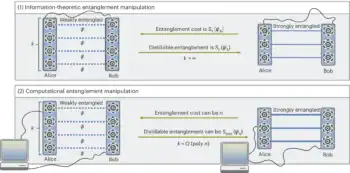
Not observing a theoretically predicted feature in an experiment can be frustrating, but it is also a crucial step for advancing science. This is what happened when a team of physicists in Austria, Denmark and Spain went looking for a feature that purportedly comes from Majorana bound states, which are exotic quasiparticles that might one day become the workhorses of quantum computing. While the physicists observed a signal with the expected characteristics, their investigations showed that it originates instead from a tiny piece of semiconducting material in the system they studied – suggesting that a different approach may be required to observe these elusive states.
In their work, Marco Valentini, Georgios Katsaros, and colleagues from the Nanoelectronics group at the Institute of Science and Technology (IST) Austria, Peter Krogstrup from Microsoft Quantum and the University of Copenhagen and Ramón Aguado and colleagues from the Institute of Materials Science Madrid ICMM at the National Spanish Research Council CSIC, studied a semiconductor-superconductor structure that is predicted to produce phenomena known as Majorana zero modes. These modes are signatures of Majorana bound states, and they should show up as peaks (technically termed zero bias conductance peaks) in the structure’s electron tunnelling spectrum. They are also the core ingredient of so-called topological quantum bits (qubits), which could provide a stable and error-resistant building block for quantum computing. To date, however, no such topological qubit has been made.
“Half-electrons”
Originally, Majorana zero modes were simply a mathematical construction that allowed an electron to be described theoretically as being composed of two halves. From a quantum computing perspective, they are attractive because if an electron can be “split” into two, the information it encodes as a qubit will be protected from local perturbations as long as the “half-electrons” can be stored far away from each other. “This concept is not so different from what Voldermort did in Harry Potter to protect his soul,” Katsaros explains. “He split into several horcruxes his Majorana zero modes.”
According to theory, these “half-electrons” should appear in a setup consisting of a semiconducting nanowire wrapped in a shell made from a superconducting material and placed in a magnetic field. The superconducting coating covers the nanowire completely, “pretty much like thin cannelloni (the superconductor) stuffed with a filling (the semiconductor),” Valentini says. The only part of the wire left “bare” in this so-called full-shell geometry is its tip, which forms the junction to a metal from which electrons are injected into the nanowire.
Since half-electrons are predicted to exist in this setup, Valentini and colleagues expected to observe the signal of Majorana zero modes in the nanowire. They didn’t. “First, we were confused, then frustrated,” Valentini admits. “Eventually, and in close collaboration with our theoretical colleagues in Madrid, we examined the setup, and found out what was wrong with it.”
Andreev bound states
The researchers performed tunnelling spectroscopy measurements on their setup to further investigate the role that the junction plays. They decided to vary the nanowire structure to see whether any structural effects were responsible for their results.
When they doubled the length of the uncoated junction from 100 nm to 200 nm, they found the source of the discrepancy: the exposed inner nanowire formed a quantum dot. This is a tiny piece of semiconducting material that can isolate individual quantum particles such as electrons thanks to its confined geometry. “The electrons in this quantum dot could then interact with electrons in the superconductor material coating the nanowire and thereby mimic the signal of the half-electrons (that is, the Majorana modes) we were looking for,” Valentini explains.
“Using the full-shell geometry, one can switch off and on superconductivity by means of an external magnetic flux (the so-called Little-Parks effect), which allows for a careful comparison with the theoretical results obtained by our team in Madrid,” Aguado says. “Eventually, we concluded that the zero-bias peaks measured at IST were in fact a product of quantum states known as Andreev bound states. These states result from the complex competition between electron-electron interactions in the quantum dot and superconductivity in the wire.”

Retraction of Nature paper puts Majorana research on a new path
“Mistaking this mimicking signal for a Majorana zero mode shows us how careful we have to be in our experiments and in our conclusions,” Valentini adds. “While this may seem like a step back in the search for Majorana zero modes, it actually is a crucial step forward in understanding nanowires and their experimental signals.”
The researchers, who report their work in Science, say they now hope to understand why they only see zero bias peaks when quantum dots form in the junction – a result that seems to suggest that they might never be able to achieve the right regime for obtaining Majorana zero modes in their experiments. “Was the material combination incorrect?” asks Katsaros. “Are the assumptions made in the theoretical models invalid in the experiments? Only future experiments will tell.”



